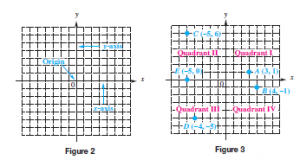Plot ordered pairs
Each of the pairs of numbers (3, 1), (25, 6), and (4, 21) is an example of an ordered pair; that is, a pair of numbers written within parentheses in which the order of the numbers is important. We graph an ordered pair using two perpendicular number lines that intersect at their 0 points, as shown in Figure 2. The common 0 point is called the origin. The position of any point in this plane is determined by referring to the horizontal number line, the x-axis, and the vertical umber line, the y-axis. The first number in the ordered pair indicates the position relative to the x-axis, and the second number indicates the position relative to the y-axis. The x-axis and the y-axis make up a rectangular (or Cartesian, for Descartes) coordinate system.
To locate, or plot, the point on the graph that corresponds to the ordered pair (3, 1), we move three units from 0 to the right along the x-axis, and then one unit up parallel to the y-axis. The point corresponding to the ordered pair (3, 1) is labeled A in Figure 3. Additional points are labeled B–E. The phrase “the point corresponding to the ordered pair (3, 1)” is often abbreviated
as “the point (3, 1).” The numbers in the ordered pairs are called components and are the coordinates of the corresponding point.

